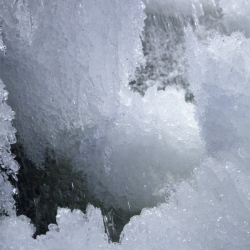
Water-rich planets are obvious candidates for finding life. The surface H2O layer on such planets (containing a liquid water ocean and possibly high-pressure ice below a specific depth) could be hundreds of kilometers deep depending on the water content and the evolution of the proto-atmosphere.
A study of possible constraints for the habitability of deep water layers and introduce a new habitability classification relevant for water-rich planets (from Mars-size to super-Earth-size planets). A new ocean model has been developed that is coupled to a thermal evolution model of the mantle and core. Their interior structure model takes into account depth-dependent thermodynamic properties and the possible formation of high-pressure ice.
They find that heat flowing out of the silicate mantle can melt an ice layer from below (in some cases episodically), depending mainly on the thickness of the ocean-ice shell, the mass of the planet, the surface temperature and the interior parameters (e.g. radioactive mantle heat sources). The high pressure at the bottom of deep water–ice layers could also impede volcanism at the water–mantle boundary for both stagnant lid and plate tectonics silicate shells.
They conclude that water-rich planets with a deep ocean, a large planet mass, a high average density or a low surface temperature are likely less habitable than planets with an Earth-like ocean.
Extreme pressures can create unusual forms of ice rarely seen on Earth. To investigate what this means for other planets, Lena Noack at the Royal Observatory of Belgium and her colleagues modelled rocky worlds with very deep oceans.
They found that on a planet with the mass of Earth, a layer of high-pressure ice can form in oceans at depths of around 170 kilometers – more than 15 times that of the lowest point in Earth’s oceans.
Given ample heat from the planet’s interior, water can remain liquid under the ice long enough for life to take hold. The model works for planets up to 10 Earth masses – beyond that, the pressure of the planet’s gravity prevents a second layer of water from forming below the ice.
Noack says two exoplanets that could host such oceans are Kepler 62e and 62f, both of which were discovered in 2013. Their radii are 1.6 and 1.4 times that of Earth, respectively, and although their masses are uncertain, they might have densities that indicate a high water content.
Jupiter’s moon Ganymede and Saturn’s moon Titan have a lot of water as a proportion of its mass, far more than Earth does. These moons could have high-pressure ice covering a liquid layer, and Noack plans to apply her models there.
Highlights
• High-pressure ice does not necessarily rule out habitability of water-rich planets.
• Increasing surface temperature leads to deeper oceans by 15% per 10 K.
• Decreasing iron content leads to deeper oceans by 6% per 10wt-%.
• Models predict that HP (high pressure) ice can be (episodically) molten at the bottom.
• Deep water layers hinder mantle volcanism depending on planet mass and plate tectonics.
